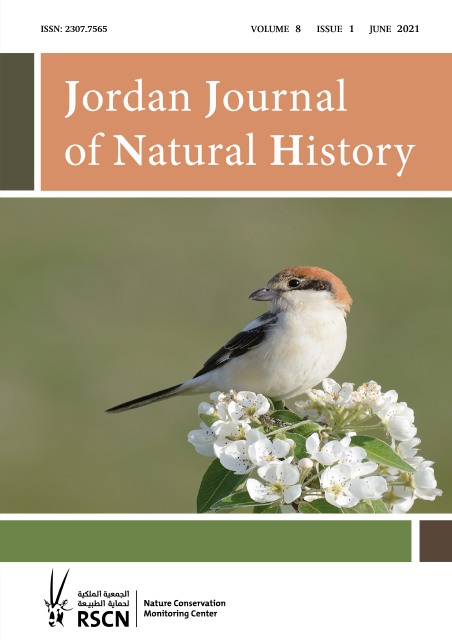Articles
New Data on the Coastal Fly Fauna (Diptera: Calliphoridae, Rhinophoridae, Sarcophagidae) of the Kherson Region (Ukraine)
Author Name
Yuri G. Verves, Liudmyla A. Khrokalo and Kostiantyn Yu. Verves
The faunistic lists for the Kherson region of Ukraine are updated based on a literature review and a recent collecting trip in August 2020. The faunas of the following oestroid families are updated: seven genera and twenty-two species of Calliphoridae, including one species [Lucilia richardsi Collin, 1926] recorded for the first time in this region; four genera and four species of Rhinophoridae, including two species [Paykullia maculata (Fallén, 1815) and Phyto melanocephala (Meigen, 1824)] recorded for the first time in the region; forty-four genera and eighty-eight species of Sarcophagidae. Original data on the behaviour of adult flies feeding on aphid excreta on leaves of Lycium barbarum Linnaeus, 1753 (Solanaceae) and flowering plants of Seseli tortuosum Linnaeus, 1753 (Apiaceae) are also provided.
The Conservation Status of Woodchat Shrike Lanius senator in Armenia
Author Name
Karen Aghababyan and Anush Khachatryan
The population of Woodchat Shrike was monitored in Armenia from 2003 to 2019. The species was found in Southern and South-eastern Armenia, inhabiting the semi-desert and the lower belt of juniper woodlands at an elevation ranging from 450 to 1500 meters above sea level. Its extent of occurrence is estimated at 4,513 km2 and its area of occupancy – at1,968 km2. In 2019, the population was estimated at 5,370 – 11,100 breeding pairs. The population trend shows a moderate decline during the period 2003-2019 (p<0.01), being reduced to 32% during the past decade (2010-2019). There are no direct threats to the species, but it declines in the lands transformed under horticultural needs and in the vicinities of an open-pit metal mine. The conservation status of the species is evaluated as Vulnerable according to criteria A2b+B1+B2abv. The following measures for the conservation of this species are suggested: (1) officially designate the proposed Emerald Sites and begin the development of some monitoring and management plans, (2) carefully assess every new horticultural project, which could occupy the native semi-deserts; (3) introduce new schemes in livestock husbandry for a sustainable grazing in semi-desert areas; (4) study the causes behind the species’ decline in the vicinity of the mining areas, (5) raise public awareness about the species, and (6) continue with the species monitoring.
Olive Groves’ Avifauna in Lebanon: The Composition of Bird Species and the Importance of the Inter-Relation Olive Ecosystem and Bird Diversity
Author Name
Ghassan Ramadan-Jaradi and Mona Ramadan-Jaradi
This study deals with the composition of the avifauna in the olive
groves of the West Beqaa Valley and Rachaya, and the interrelation between birds and olive groves. The study documents the breeding of twenty-two bird species in these olive groves, as well as the existence of twentysix breeding species in the study site coming from the neighboring habitats. In addition, twenty-five species were recorded as passage migrants and/or winter visitors. The benefits provided by olive groves to the various species of the studied birds and the services in return offered by birds to the olive trees are discussed. This is the first study in Lebanon that is dedicated to the study of olive groves and their birds. It demonstrates that the interrelation between birds and olive groves is a perfect example for the understanding of the importance of biodiversity in developing agricultural production and improving its quantity and quality.
A Quantitative Analysis of the Woody Vegetation in Ajloun Forest Reserve- Jordan
Author Name
Anas E. Abu Yahya and Sameh Khatatbeh
Ajloun Forest Reserve was established to conserve the evergreen oak (Quercus coccifera L.), which is one of the only four forest types that have been recorded in Jordan. There are many forces which cause degradation for such ecosystems, including natural (low rainfall, drought) and human (overgrazing, firing, woodcutting) factors. The objective of this study is to assess the status of vegetation structure in terms of the existing woody species using vegetation attributes. This will provide scientific-based tools for the management to identify the trend of the forest. The survey was carried out in October 2016 using 102 macro-plots with a micro-plot located in the center. The woody plants were classified into three basic classes: trees, shrubs, and climbers; also their regeneration and their vegetation attributes (density, frequency, abundance, and their relatives) were calculated. The results revealed that the estimated woody area is 54% and the ground cover is 46% of the reserve. As for the tree layer, Quercus coccifera L. exhibited the highest values and Phillyrea latifolia L. showed the lowest values. Trees’ regeneration showed the same trend. As for eclimbers’ layer, Smilex aspera L. showed the highest values, while Ephedra aphylla Forssk. has the lowest values. The same results apply to the climbers’ regeneration. As for the shrubs’ layer, Cistus creticus L. recorded the highest values and Ruta chalepensis L. recorded the lowest values. As for their regenerations, Cistus creticus L. recorded the highest values while some species recorded a zero value. The structure of the Ajloun Forest Reserve is composed mostly of Quercus coccifera L. with high values of density parameter. The regeneration
A Local Community Participatory Approach as a New Policy toward a Complementary in situ Conservation of the Agrobiodiversity in Saint Katherine, South Sinai- Egypt
Author Name
Reda Rizk, Ibrahim Elgamal and Sami Rabei
Changes in social lifestyles and fruit diversity occur gradually at Saint Katherine. Saint Katherine was more isolated during the occupation period (1967-1982). This study provides a significant and brief description of the most important features of the society study in Saint Katherine concerning the effects of location and the natural properties on the conservation of the agrobiodiversity. The sources of horticulture crop propagules are mainly from the local nurseries as native breeds and/or from nurseries outside the governorate. The study recorded fifteen fruit crops in the horticulture garden of Saint Katherine.The situational factors impose some sort of separation or isolation making that the exchange of genetic assets for cultivated horticulture crops limited. People had to use the existing genetic resources or ones imported from abroad. So, genetic resources of the cultivated crops become adapted to the local environment. After 1982, some cultivars were introduced from an Agricultural Nursery. For such reason, Saint Katherine is considered as a unique store for specific fruit cultivars. Horticulture crop diversity is also in decline and continues to be threatened by drought, climate change, habitat destruction, rainfloods, unsustainable use of natural resources, and by the replacement of the native cultivars with unsuitable new cultivars.
Professor Dawud M H. Al-Eisawi (1946-2020)
Author Name
Nashat A. Hamidan
It is with great regret that we learned of the untimely death of Professor Dawud Al- Eisawi, on the morning of 24th December 2020, after losing his battle against the Corona virus. He was the founder of the Jordan Journal of Natural History and closely supervised every volume for the past seven years. All those involved with the Journal, as represented by its Editorial, Associate and International Boards, were shocked and saddened by the news of his death.
A Teratological Record of the Southern Green Stink Bug Nezara viridula (Hemiptera, Heteroptera, Pentatomidae) from the Occupied Palestinian Territories (West Bank)
Author Name
Elias N. Handal
The first teratological case of Southern Green Stink Bug (Nezara virdula) from the Palestine Museum of Natural History botanical garden in Bethlehem, Palestine is reported. This anomaly appears on the pronotum, scutellum and the corium part of the species, and it seems to occur less in these morphological structures of true bugs (Heteroptera).
Towards Improving Conservation Strategies for the Endangered Arabian Wolf, Canis lupus arabs
Author Name
Gavin T. Bonsen and Anton Khalilieh
While wolf populations are recovering globally (Chapron et al., 2014; Mech 2017), the International Union for Conservation of Nature (IUCN) lists the unique desertadapted Arabian wolf, Canis lupus arabs, as an endangered subspecies (Mallon and Budd 2011). Ranging across arid regions of the southern Levant and Arabian Peninsula, the Arabian wolf often relies on human resources (Shalmon 1986); this may be attributed to a severely depleted natural prey base coupled with the low productivity of arid and hyper-arid environments. Where conflict with wolves is low, such as in crop farming landscapes throughout Al Naqab and Wadi Araba, Arabian wolves have developed such an affinity with humans that they rarely venture more than 5 km from human infrastructure (Barocas et al., 2018).
Tail Malformation in Ablepharus rueppellii (Reptilia: Scincidae) from the Occupied West Bank, Palestine
Author Name
Elias N. Handal
This is the first record of a symmetrical bifurcation and malformation in the tail of Festa’s skink, Ablepharus rueppellii, in the West Bank, Palestine




